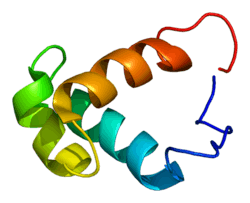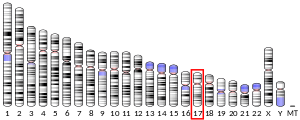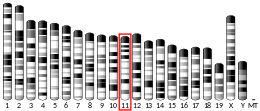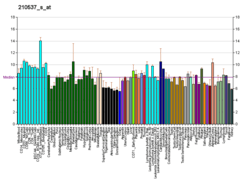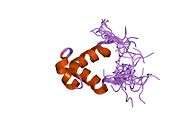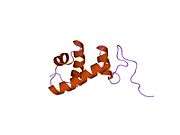TADA2L
Transcriptional adapter 2-alpha is a protein that in humans is encoded by the TADA2A gene.[5][6]
Function
Many DNA-binding transcriptional activator proteins enhance the initiation rate of RNA polymerase II-mediated gene transcription by interacting functionally with the general transcription machinery bound at the basal promoter. Adaptor proteins are usually required for this activation, possibly to acetylate and destabilize nucleosomes, thereby relieving chromatin constraints at the promoter. The protein encoded by this gene is a transcriptional activator adaptor and has been found to be part of the PCAF histone acetylase complex. Two transcript variants encoding different isoforms have been identified for this gene.[6]
Interactions
TADA2L has been shown to interact with GCN5L2,[7][8] TADA3L[9][10] and Myc.[11]
References
- ENSG00000277104 GRCh38: Ensembl release 89: ENSG00000276234, ENSG00000277104 - Ensembl, May 2017
- GRCm38: Ensembl release 89: ENSMUSG00000018651 - Ensembl, May 2017
- "Human PubMed Reference:". National Center for Biotechnology Information, U.S. National Library of Medicine.
- "Mouse PubMed Reference:". National Center for Biotechnology Information, U.S. National Library of Medicine.
- Candau R, Moore PA, Wang L, Barlev N, Ying CY, Rosen CA, Berger SL (Feb 1996). "Identification of human proteins functionally conserved with the yeast putative adaptors ADA2 and GCN5". Molecular and Cellular Biology. 16 (2): 593–602. doi:10.1128/mcb.16.2.593. PMC 231038. PMID 8552087.
- "Entrez Gene: TADA2L transcriptional adaptor 2 (ADA2 homolog, yeast)-like".
- Barlev NA, Poltoratsky V, Owen-Hughes T, Ying C, Liu L, Workman JL, Berger SL (Mar 1998). "Repression of GCN5 histone acetyltransferase activity via bromodomain-mediated binding and phosphorylation by the Ku-DNA-dependent protein kinase complex". Molecular and Cellular Biology. 18 (3): 1349–58. doi:10.1128/mcb.18.3.1349. PMC 108848. PMID 9488450.
- Wang L, Mizzen C, Ying C, Candau R, Barlev N, Brownell J, Allis CD, Berger SL (Jan 1997). "Histone acetyltransferase activity is conserved between yeast and human GCN5 and is required for complementation of growth and transcriptional activation". Molecular and Cellular Biology. 17 (1): 519–27. doi:10.1128/mcb.17.1.519. PMC 231776. PMID 8972232.
- Rual JF, Venkatesan K, Hao T, Hirozane-Kishikawa T, Dricot A, Li N, Berriz GF, Gibbons FD, Dreze M, Ayivi-Guedehoussou N, Klitgord N, Simon C, Boxem M, Milstein S, Rosenberg J, Goldberg DS, Zhang LV, Wong SL, Franklin G, Li S, Albala JS, Lim J, Fraughton C, Llamosas E, Cevik S, Bex C, Lamesch P, Sikorski RS, Vandenhaute J, Zoghbi HY, Smolyar A, Bosak S, Sequerra R, Doucette-Stamm L, Cusick ME, Hill DE, Roth FP, Vidal M (Oct 2005). "Towards a proteome-scale map of the human protein-protein interaction network". Nature. 437 (7062): 1173–8. doi:10.1038/nature04209. PMID 16189514.
- Wang T, Kobayashi T, Takimoto R, Denes AE, Snyder EL, el-Deiry WS, Brachmann RK (Nov 2001). "hADA3 is required for p53 activity". The EMBO Journal. 20 (22): 6404–13. doi:10.1093/emboj/20.22.6404. PMC 125723. PMID 11707411.
- Liu X, Tesfai J, Evrard YA, Dent SY, Martinez E (May 2003). "c-Myc transformation domain recruits the human STAGA complex and requires TRRAP and GCN5 acetylase activity for transcription activation". The Journal of Biological Chemistry. 278 (22): 20405–12. doi:10.1074/jbc.M211795200. PMC 4031917. PMID 12660246.
Further reading
- Maruyama K, Sugano S (Jan 1994). "Oligo-capping: a simple method to replace the cap structure of eukaryotic mRNAs with oligoribonucleotides". Gene. 138 (1–2): 171–4. doi:10.1016/0378-1119(94)90802-8. PMID 8125298.
- Wang L, Mizzen C, Ying C, Candau R, Barlev N, Brownell J, Allis CD, Berger SL (Jan 1997). "Histone acetyltransferase activity is conserved between yeast and human GCN5 and is required for complementation of growth and transcriptional activation". Molecular and Cellular Biology. 17 (1): 519–27. doi:10.1128/mcb.17.1.519. PMC 231776. PMID 8972232.
- Carter KC, Wang L, Shell BK, Zamir I, Berger SL, Moore PA (Mar 1997). "The human transcriptional adaptor genes TADA2L and GCN5L2 colocalize to chromosome 17q12-q21 and display a similar tissue expression pattern". Genomics. 40 (3): 497–500. doi:10.1006/geno.1996.4605. PMID 9073520.
- Henriksson A, Almlöf T, Ford J, McEwan IJ, Gustafsson JA, Wright AP (Jun 1997). "Role of the Ada adaptor complex in gene activation by the glucocorticoid receptor". Molecular and Cellular Biology. 17 (6): 3065–73. doi:10.1128/mcb.17.6.3065. PMC 232159. PMID 9154805.
- Suzuki Y, Yoshitomo-Nakagawa K, Maruyama K, Suyama A, Sugano S (Oct 1997). "Construction and characterization of a full length-enriched and a 5'-end-enriched cDNA library". Gene. 200 (1–2): 149–56. doi:10.1016/S0378-1119(97)00411-3. PMID 9373149.
- Ogryzko VV, Kotani T, Zhang X, Schiltz RL, Howard T, Yang XJ, Howard BH, Qin J, Nakatani Y (Jul 1998). "Histone-like TAFs within the PCAF histone acetylase complex". Cell. 94 (1): 35–44. doi:10.1016/S0092-8674(00)81219-2. PMID 9674425.
- Vassilev A, Yamauchi J, Kotani T, Prives C, Avantaggiati ML, Qin J, Nakatani Y (Dec 1998). "The 400 kDa subunit of the PCAF histone acetylase complex belongs to the ATM superfamily". Molecular Cell. 2 (6): 869–75. doi:10.1016/S1097-2765(00)80301-9. PMID 9885574.
- Wang T, Kobayashi T, Takimoto R, Denes AE, Snyder EL, el-Deiry WS, Brachmann RK (Nov 2001). "hADA3 is required for p53 activity". The EMBO Journal. 20 (22): 6404–13. doi:10.1093/emboj/20.22.6404. PMC 125723. PMID 11707411.
- Barlev NA, Emelyanov AV, Castagnino P, Zegerman P, Bannister AJ, Sepulveda MA, Robert F, Tora L, Kouzarides T, Birshtein BK, Berger SL (Oct 2003). "A novel human Ada2 homologue functions with Gcn5 or Brg1 to coactivate transcription". Molecular and Cellular Biology. 23 (19): 6944–57. doi:10.1128/MCB.23.19.6944-6957.2003. PMC 193946. PMID 12972612.
- Rual JF, Venkatesan K, Hao T, Hirozane-Kishikawa T, Dricot A, Li N, Berriz GF, Gibbons FD, Dreze M, Ayivi-Guedehoussou N, Klitgord N, Simon C, Boxem M, Milstein S, Rosenberg J, Goldberg DS, Zhang LV, Wong SL, Franklin G, Li S, Albala JS, Lim J, Fraughton C, Llamosas E, Cevik S, Bex C, Lamesch P, Sikorski RS, Vandenhaute J, Zoghbi HY, Smolyar A, Bosak S, Sequerra R, Doucette-Stamm L, Cusick ME, Hill DE, Roth FP, Vidal M (Oct 2005). "Towards a proteome-scale map of the human protein-protein interaction network". Nature. 437 (7062): 1173–8. doi:10.1038/nature04209. PMID 16189514.
- Qian C, Zhang Q, Li S, Zeng L, Walsh MJ, Zhou MM (Dec 2005). "Structure and chromosomal DNA binding of the SWIRM domain". Nature Structural & Molecular Biology. 12 (12): 1078–85. doi:10.1038/nsmb1022. PMID 16299514.
